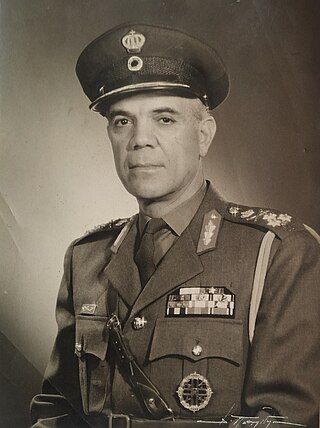
The Hellenic Armed Forces are the military forces of Greece. They consist of the Hellenic Army, the Hellenic Navy, and the Hellenic Air Force.
The United States Armed Forces are the military forces of the United States. The armed forces consist of six service branches: the Army, Marine Corps, Navy, Air Force, Space Force, and Coast Guard. All six armed services are among the eight uniformed services of the United States.

The Portuguese Armed Forces are the military of Portugal. They include the General Staff of the Armed Forces, the other unified bodies and the three service branches: Portuguese Navy, Portuguese Army and Portuguese Air Force.

A brigade is a major tactical military formation that typically comprises three to six battalions plus supporting elements. It is roughly equivalent to an enlarged or reinforced regiment. Two or more brigades may constitute a division.

The Hellenic Army, formed in 1828, is the land force of Greece. The term Hellenic is the endogenous synonym for Greek. The Hellenic Army is the largest of the three branches of the Hellenic Armed Forces, also constituted by the Hellenic Air Force (HAF) and the Hellenic Navy (HN). The army is commanded by the chief of the Hellenic Army General Staff (HAGS), which in turn is under the command of Hellenic National Defence General Staff (HNDGS).

Odysseus Aggelis was a Greek nationalist military officer of the Artillery [Reg. Number 19386]. He reached the rank of four star General and served as Chief of the Greek Armed Forces and Vice President of the Hellenic Republic. He supported the military regime that was established on April 21, 1967.

The Indonesian Army is the land branch of the Indonesian National Armed Forces. It has an estimated strength of 300,400 active personnel. The history of the Indonesian Army has its roots in 1945 when the Tentara Keamanan Rakyat (TKR) "People's Security Forces" first emerged as a paramilitary and police corps.

The Royal New Zealand Army Logistic Regiment, is the New Zealand Army's main military Logistics and combat service support (CSS) element. It is the largest regiment in the NZ Army.
Hellenic Army is commanded by the Hellenic Army General Staff which supervises five major commands. These are:
General Dimitrios Grapsas is a Greek military officer, who served as the Chief of the Hellenic National Defense General Staff from August 2007 to August 2009.

The United States Marine Corps is organized within the Department of the Navy, which is led by the Secretary of the Navy (SECNAV). The most senior Marine commissioned officer is the Commandant of the Marine Corps, responsible for organizing, recruiting, training, and equipping the Marine Corps so that it is ready for operation under the command of the unified combatant commanders. The Marine Corps is organized into four principal subdivisions: Headquarters Marine Corps, the Operating Forces, the Supporting Establishment, and the Marine Forces Reserve.
In the United States Army, the term combat support refers to units that provide fire support and operational assistance to combat elements. Combat support units provide specialized support functions to combat units in the following areas

The Hellenic Army General Staff is the general staff of the Hellenic Army, the terrestrial component of the Greek Armed Forces. It was established in 1904. Since 1950, the HAGS is subordinated to the Hellenic National Defence General Staff. The Chief of the HAGS is the head of the Hellenic Army.
The I Army Corps was an army corps of the Hellenic Army, founded in December 1913. Originally based in Athens and covering southern Greece, since 1962 it was responsible for covering Greece's northwestern borders. It was disbanded in 2013.

The structure of the United States Army is complex, and can be interpreted in several different ways: active/reserve, operational/administrative, and branches/functional areas.
Grigorios Spandidakis was a Hellenic Army officer who rose to the rank of Lieutenant General and the post of Chief of the Hellenic Army General Staff in 1965–1967. From this position, he was instrumental in the military preparations that resulted in the coup d'état of 21 April 1967 and the establishment of the Regime of the Colonels. He served as Deputy Prime Minister and Minister for National Defence in the first government of the new regime, but was dismissed after supporting the failed counter-coup attempt launched by King Constantine II on 13 December 1967. After the fall of the regime, he was tried and convicted to life imprisonment for his role in it. He secured an early release on health grounds and died in 1996.

Konstantinos Ventiris was a Hellenic Army officer who rose to the rank of lieutenant general. He served twice as Chief of the Hellenic Army General Staff and was one of the senior government commanders during the Greek Civil War. He is also one of the few recipients the country's highest wartime decoration, the Commander's Cross of the Cross of Valour.
Athanasios Tselios is a retired Hellenic Army officer and former Chief of the Hellenic Army General Staff.
Vassilios or Vasileios Tellidis is a Hellenic Army officer who in 2015–2017 served as Chief of the Hellenic Army General Staff.